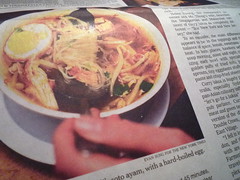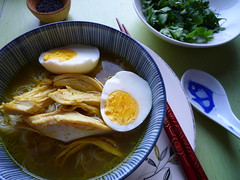New Ways to Boost Your Grain Power 3: Oats!
 fig. a toaster, oats
fig. a toaster, oats
It's funny that this is the last recipe to appear in the New Ways to Boost Your Grain Power series, because in many ways this was the recipe that got me started on this train of thought.
It all started back in about the spring of 2010. I'd been reading and re-reading issue #82 of The Art of Eating (Fall 2009) for a while, especially its cover story on new bistros and "the casualization of dining" in Paris ("New Ways to be a Restaurant in Paris," by Bénédict Beaugé and Edward Behr). I was fascinated by its description of the new crop of bistros and micro-bistros in Paris, and the way these restaurants were redefining the dining scene there: by making it less stuffy and more affordable, yes, but also by highlighting regional cuisines in a way that was helping to expand notions of bistro cuisine. And I studied the accompanying recipes closely. Very closely, in fact, because there was one recipe that I just couldn't wrap my head around.
It was a recipe for Haferflockensuppe from Nicholas Scheidt of L'Office, and it was billed as an Alsatian specialty. You see, I'd yet to Boost My Grain Power back then, and it literally took me weeks to decipher what I was reading. I couldn't figure out why this wouldn't just result in an unusually savoury bowl of oatmeal. Finally, after going back to that same recipe over and over and over again, it suddenly made sense to me. I had something of a "Eureka!" moment. It wasn't just an "oatmeal soup" (as a strict translation of the name would suggest), like every other recipe in this New Ways to Boost Your Grain Power series, the key had to do with the toasting of grains--in this case, the toasting of oats. You see, it may very well be that mairzy doats and dozy doats and liddle lamzy divey, and that's all fine and good, but, here, it's very important that you begin this recipe with toasted oats.
With its combination of butter, bacon, oats, cognac, sour cream, and chicken stock, this might seem like kind of a wintery soup, and it is, but it's actually pretty ideal as an early spring soup, too, especially around here, where the fluctuations in temperature can be a bit of a rollercoaster ride (a cruel one) in March and April. You see, it's got some of the greens that you're craving, like chervil and spring onions, but it's also plenty hearty enough for an unseasonably brisk day. (In fact, tomorrow would be an ideal day for Haferflockensuppe--it's predicted that we're going to get 10-15 cm of snow [?!!].) And it's easy, too, once you have the necessary ingredients, including a good (homemade, preferably) chicken stock. You just have to take the time to carefully brown your oats to toasty, golden perfection, and everything else pretty well takes care of itself.
I offer you the recipe as it originally appeared in The Art of Eating. I've found that one can tone down the amount of butter and oil significantly, and still wind up with the desired richness of flavour. Everything else I'd keep exactly as is, although if you happen to have pumpernickel croutons around, instead of plain old country bread croutons, all the better.
Haferflockensuppe
75g oat flakes (3/8 cup)
100g butter (1/2 cup)
4 tsp veg oil
2 cloves garlic, crushed
1 thick slice bacon, cut into lardons
2 bay leaves
2 tbsp cognac
1 litre chicken stock
salt and pepper
4 eggs
1 slice country bread, cut into croutons
chervil, 1 bunch, minced
spring onions, thinly sliced
4 tsp sour cream
Brown the oat flakes in half the butter and half the oil, with the garlic, bacon and bay leaves. Deglaze with the cognac, add stock and simmer 20 min. Remove the bay leaves and season to taste.
Pan fry the eggs (or poach them for a finer look and taste), season them, brown the croutons in the remaining oil and butter, and season.
Slide one egg in the bottom of each soup bowl (shallow ones make for a more dramatic presentation), pour some soup around it so the yolk still emerges, sprinkle with chervil, croutons, and spring onions. Finish with a dollop of sour cream.
aj










